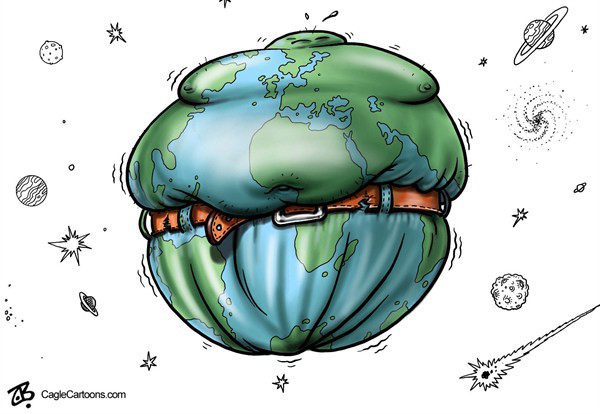We Have a Population Problem
Population, Ecology, and Environmentalism

To Robert Sulnick’s piece highlighting population as an integral part of the climate change discussion, I would add that population is the centerpiece and source of the ecological problems facing our planet: Climate change and pollution are merely the expected results of an out-of-control population.
Imagine, if you will, 7.5 billion chimpanzees running around the planet, eating everything in sight, decimating ecosystems, and, literally, throwing their excrement everywhere. Horrible image, I know, but that’s pretty much what we do. We are, after all, The Third Chimpanzee (chimps, bonobos and humans) as Jared Diamond’s book describes so well. The actual planetary population of chimps is about 300,000; bonobos about 50,000; orangutans 77,000, and about 105,000 gorillas. Homo sapiens sapiens tips the scale at 7.5 billion, totally out of balance with biology and ecology. We have already created this horrible ecological disaster, and we have been in the midst of it since 1804 (when planetary population reached 1 billion).
Future projections are that our population will grow to our planet’s “maximum carrying capacity” of about 10 billion-12 billion individuals and then level off. “Level off” is a kind of benign term for the 3 billion-4 billion more people who will be living in abject poverty, will starve, and who will suffer the resurgence of vast epidemics, as well as premature death, and the terror of increased warfare and dictatorship as we fight for ever scarcer natural resources.
With our crafty human brains, it seems like we could plan our future a little bit better.
As a science teacher, I think we do a terrible job of teaching our children about the science of ecology, the branch of biology that studies organisms in relation to one another and to their environment. Instead, we teach our children about the ideology and political philosophy of environmentalism, a social movement with political, moral, and even religious overtones. As educators we are supposed to remember “Teaching Not Preaching.” Instead our schools have taken up an almost religious fervor in indoctrinating our students with political action environmentalism. We guilt trip our students about all the things they should be doing (eat low on the food chain, use renewable energy sources, etc.), how horribly we damage Mother Earth (and we do), all of which will very soon and catastrophically result in environmental doom.
In spite of all this pervasive, almost religious fire and brimstone, we do nothing to address the source of the problem and its solution:
We don’t have a political action, environmental problem: We have a population problem.
In some courses on environmentalism, population is barely discussed: a paragraph here, a short discussion there. The fatalistic strategy seems to be, “We can’t do anything about population so let’s ignore it and preach about the environmental correctness of eating low on the food chain. We’ll instantly feel good about our environmental awareness and be involved in contributing to its improvement,” even though we’re ignoring the fundamental cause of all climate change and pollution. All sustainable practices are individually helpful, but not if they cause us to set up political and educational systems that ignore the problem and its solution. And that is exactly what we have done. Schools should be educating our children about the science of ecology, not preaching political action environmentalism and “feel good” strategies that cause the next generations to ignore the population problem.
Reducing population has an immediate and profound effect upon all environmental problems. Having one less child — and all the subsequent children that child and that child’s children will have down through the generations — has an individually enormous impact on our environment. In comparison, taking public transportation and installing tax-subsidized solar panels have a miniscule effect.
It took us 200 years to grossly overpopulate and ruin our relationship to our planet. If we take that long-term view, we can fix our mistakes through education: no “feel good,” immediate gratification or heavy handed laws, rules and tax penalties, just the education of our children. If it takes a 200-year, multi-generational project to restore our planet to a sustainable population, then let’s begin now with a focus on the problem and its solution.
Consider the “Have One Less Child” strategy:
• This idea is predicated upon education, personal responsibility, having wanted children, and the reduction of infant mortality around the world.
• Everyone can always have one, two, or even three children, and our planetary population will steadily decline.
• If you want four children, have three. If you want five children, have four, and so on.
During our entire lifetime, we have only one, brief moment when we can have an individually significant impact on our planet. You want to save the earth? Have one less child.



